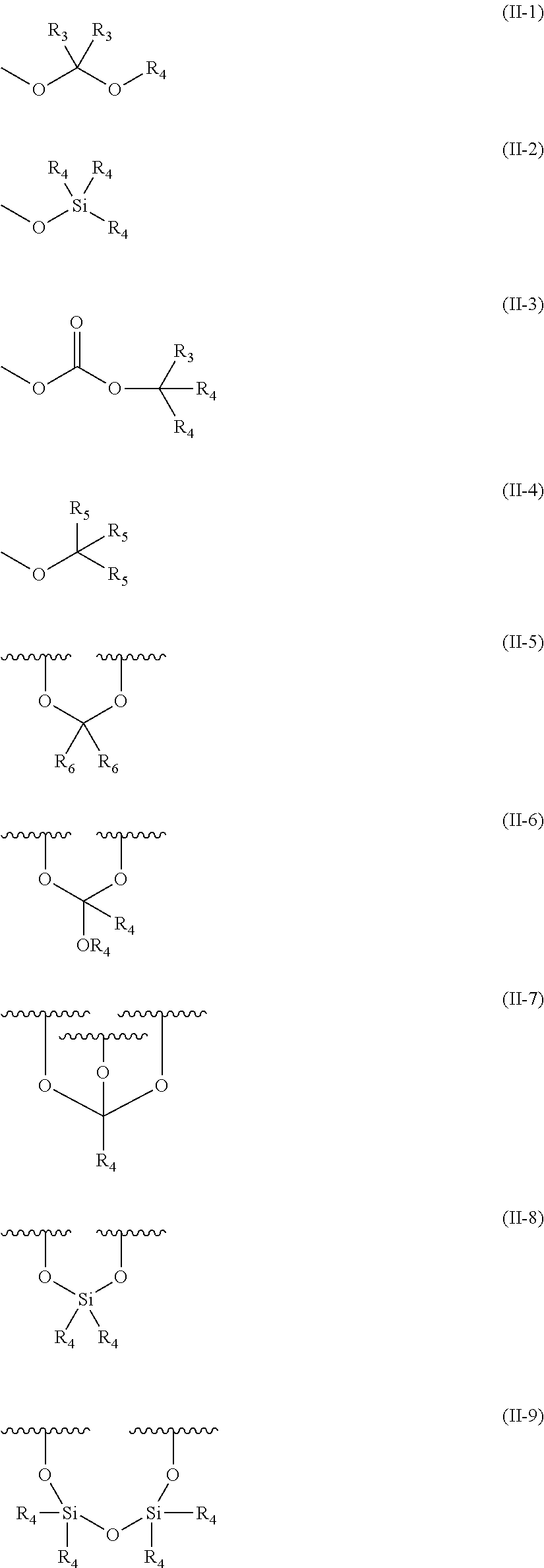Pattern forming method and resist composition
a pattern and composition technology, applied in the field of pattern forming method and resist composition, can solve the problems of difficulty in discovering an appropriate combination of resist composition, etc., and achieves excellent sensitivity, limiting resolving power, roughness characteristic, etc.
- Summary
- Abstract
- Description
- Claims
- Application Information
AI Technical Summary
Benefits of technology
Problems solved by technology
Method used
Image
Examples
synthetic example 1
Resin (A-1)
[0697]In a nitrogen stream, 200 g of cyclohexanone was placed in a three-necked flask, and heated at 80° C. Thus, a solvent 1 was obtained. Separately, the following monomer-1 (29.7 g) and monomer-2 (71.4 g) were dissolved in cyclohexanone (372 g), thereby obtaining a monomer solution. Further, a polymerization initiator V601 (produced by Wako Pure Chemical Industries, Ltd.) was added in an amount of 6.6 mol % based on the total amount of monomers to the solution and dissolved therein. The thus obtained solution was dropped into the solvent 1 over a period of six hours. After the completion of the dropping, reaction was continued at 80° C. for two hours. The reaction liquid was allowed to cool, and dropped into a liquid mixture of 7736 g of heptane and 859 g of ethyl acetate. The thus precipitated powder was collected by filtration and dried. Thus, 73 g of resin (A-1) was obtained. With respect to the thus obtained resin (A-1), the weight average molecular weight was 9800...
synthetic example 2
Resins (A-2) to (A-55)
[0698]The resins (A-2) to (A-55) were synthesized in the same manner as in Synthetic Example 1. With respect to each of these resins, the weight average molecular weight, the molecular weight dispersity (Mw / Mn), and the component ratio were as given in Table 1 above.
[0699]
synthetic example 3
Hydrophobic Resin (1b)
[0700]The hydrophobic resin (1b) shown below was synthesized in the following manner. Namely, the monomers corresponding to the individual repeating units of the hydrophobic resin (1b) were charged in a proportion of 40 / 60 (molar ratio) and dissolved in propylene glycol monomethyl ether acetate (PGMEA). Thus, 450 g of a solution of 15 mass % solid content was obtained. A polymerization initiator V60 produced by Wako Pure Chemical Industries, Ltd. was added in an amount of 1 mol % to the solution. In a nitrogen stream, the resultant mixture was dropped into 50 g of PGMEA heated at 100° C. over a period of six hours. After the completion of the dropping, the reaction liquid was agitated for two hours. After the completion of the reaction, the reaction liquid was allowed to cool to room temperature and precipitated in 5 liters of methanol. The thus precipitated white powder was collected by filtration, thereby recovering desired resin (1b).
[0701]The polymer compon...
PUM
| Property | Measurement | Unit |
|---|---|---|
| mass % | aaaaa | aaaaa |
| wavelength | aaaaa | aaaaa |
| optical purity | aaaaa | aaaaa |
Abstract
Description
Claims
Application Information
 Login to View More
Login to View More - R&D
- Intellectual Property
- Life Sciences
- Materials
- Tech Scout
- Unparalleled Data Quality
- Higher Quality Content
- 60% Fewer Hallucinations
Browse by: Latest US Patents, China's latest patents, Technical Efficacy Thesaurus, Application Domain, Technology Topic, Popular Technical Reports.
© 2025 PatSnap. All rights reserved.Legal|Privacy policy|Modern Slavery Act Transparency Statement|Sitemap|About US| Contact US: help@patsnap.com



